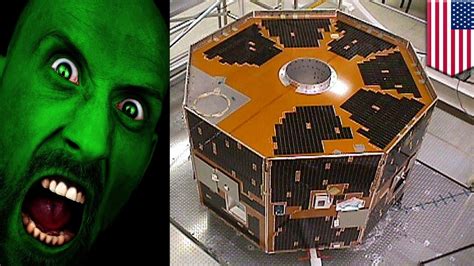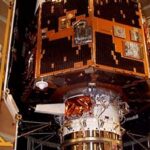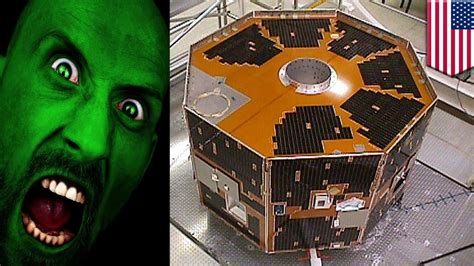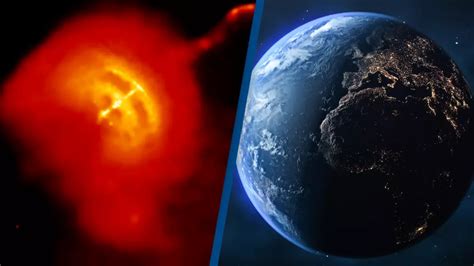
A long-dead NASA satellite, known as IMAGE (Imager for Magnetopause-to-Aurora Global Exploration), has unexpectedly emitted a mysterious energy blast, puzzling scientists who believed the spacecraft had been defunct since 2005. The unexpected resurgence has prompted NASA to analyze the signals to determine the cause and implications of this unusual activity from the “zombie satellite.”
NASA’s Defunct IMAGE Satellite Resurfaces with Enigmatic Energy Emission
A NASA satellite, the Imager for Magnetopause-to-Aurora Global Exploration (IMAGE), presumed dead for nearly two decades, has startled the scientific community by emitting a mysterious energy blast. The sudden activity from the “zombie satellite,” which ceased operations in 2005, has prompted an investigation into the potential causes and implications of this unexpected revival.
The IMAGE satellite, launched in 2000, was designed to study the Earth’s magnetosphere and its response to solar wind. It provided groundbreaking data on the dynamic processes occurring in this region, including the formation and behavior of auroras. However, communication with the satellite was lost in 2005, leading NASA to declare the mission over. The recent signal detection has ignited a flurry of activity as scientists attempt to understand the source and nature of the emitted energy.
“The unexpected signal from IMAGE has caught the attention of space weather experts and engineers alike,” stated a NASA spokesperson. “The team is currently analyzing the data to ascertain the cause of this anomalous behavior and to determine if any of the onboard instruments are still functional.”
The implications of this event are far-reaching. If the satellite can be revived, it could potentially provide valuable data on the current state of the magnetosphere and offer a unique perspective on how space weather conditions have evolved over the past two decades. On the other hand, the unexpected emission could pose challenges to other active satellites in orbit, necessitating further investigation and assessment of potential risks.
Background of the IMAGE Mission
The IMAGE mission was a pivotal component of NASA’s Sun-Earth Connection program, aimed at understanding the complex interactions between the Sun and the Earth’s environment. The satellite carried a suite of instruments designed to image various aspects of the magnetosphere, including plasma populations, magnetic fields, and auroral emissions. Its innovative imaging techniques allowed scientists to visualize the global structure of the magnetosphere and to study its dynamic response to solar activity.
During its operational period, IMAGE provided valuable insights into a range of phenomena, including:
- Magnetospheric Substorms: IMAGE captured detailed images of substorms, which are sudden releases of energy from the magnetosphere that can disrupt communication systems and power grids on Earth.
- Auroral Dynamics: The satellite provided unprecedented views of auroras, revealing their complex morphology and dynamics.
- Plasma Transport: IMAGE tracked the movement of plasma within the magnetosphere, shedding light on the processes that control the distribution of particles in this region.
- Geocorona Studies: IMAGE provided valuable data about the Earth’s geocorona, the outermost layer of the atmosphere, which extends far into space.
The loss of communication with IMAGE in 2005 was a significant setback for the space science community. Despite numerous attempts to re-establish contact, the satellite remained silent until the recent unexpected signal detection.
Possible Explanations for the Resurgence
Several theories have been proposed to explain the sudden resurgence of the IMAGE satellite. These include:
- Battery Revival: One possibility is that the satellite’s batteries, after years of inactivity, have somehow regained enough charge to power some of the onboard systems. This could be due to changes in the satellite’s orientation relative to the Sun, or to other factors that are not yet fully understood.
- Component Failure: Another possibility is that a component failure has triggered the emission of energy. For example, a short circuit in the power system could cause a sudden surge of electricity, resulting in the observed signal.
- External Interference: It is also possible that the signal is not actually coming from the IMAGE satellite at all, but is instead due to some form of external interference. This could be caused by another satellite, a ground-based transmitter, or even a natural phenomenon.
- Software Glitch: A software glitch within the satellite’s system could potentially cause it to transmit spurious signals, mimicking actual data.
- Micrometeoroid Impact: While less likely, an impact from a micrometeoroid could conceivably jolt the satellite’s systems back to life or cause a surge in electrical activity.
NASA is currently evaluating these and other possibilities to determine the most likely explanation for the resurgence.
Challenges in Re-Establishing Communication
Re-establishing communication with the IMAGE satellite presents several technical challenges. These include:
- Unknown Satellite Orientation: The satellite’s orientation in space is currently unknown, making it difficult to point antennas in the correct direction to send commands.
- Battery Condition: The condition of the satellite’s batteries is also uncertain. If the batteries are severely degraded, they may not be able to provide enough power to operate the onboard systems.
- Component Degradation: After nearly two decades in space, the satellite’s components may have degraded, making it difficult to operate them reliably.
- Software Issues: Software corruption or glitches could hinder the reactivation process.
- Propellant Depletion: If the satellite relied on propellant for attitude control, it is likely to be depleted, making precise maneuvering difficult.
Despite these challenges, NASA is committed to exploring all possible avenues for re-establishing communication with the IMAGE satellite. If successful, this effort could provide valuable insights into the long-term effects of space environment on satellite systems and could potentially lead to the recovery of valuable scientific data.
Potential Benefits of Reviving IMAGE
If NASA is able to revive the IMAGE satellite, it could provide several benefits to the scientific community. These include:
- Updated Magnetospheric Data: IMAGE could provide valuable data on the current state of the magnetosphere, allowing scientists to compare it with data collected during the satellite’s original mission. This could help to improve our understanding of how the magnetosphere has changed over time.
- Validation of Space Weather Models: IMAGE data could be used to validate space weather models, which are used to predict the effects of solar activity on Earth. By comparing model predictions with actual observations, scientists can improve the accuracy of these models and provide better warnings of potential space weather hazards.
- Testing of New Technologies: The effort to revive IMAGE could provide an opportunity to test new technologies for satellite recovery and repair. These technologies could be used to extend the lifespan of other satellites and to reduce the cost of space missions.
- Educational Opportunities: The IMAGE mission could serve as an educational tool for students and the public. By learning about the mission and its findings, people can gain a better understanding of the importance of space science and its impact on our lives.
- Historical Data Comparison: Comparing current data with the original mission data from the early 2000s would allow scientists to study the long-term effects of solar activity and climate change on the magnetosphere.
Impact on Space Weather Forecasting
The potential revival of the IMAGE satellite could have a significant impact on space weather forecasting. Space weather refers to the dynamic conditions in the space environment that can affect technological systems on Earth and in space. Solar flares, coronal mass ejections, and other forms of solar activity can disrupt communication systems, damage satellites, and even cause power outages.
Accurate space weather forecasting is essential for mitigating these risks. By providing real-time data on the state of the magnetosphere, IMAGE could help to improve the accuracy of space weather forecasts and provide better warnings of potential hazards. This would allow operators of critical infrastructure, such as power grids and communication networks, to take steps to protect their systems from the effects of space weather.
The Broader Context: Space Archaeology and Satellite Graveyards
The IMAGE satellite’s story highlights a growing field known as “space archaeology,” which involves studying defunct satellites and other space debris to learn about the history of space exploration. As the number of satellites in orbit continues to increase, the issue of space debris is becoming increasingly important. Defunct satellites, rocket bodies, and other objects can pose a threat to active satellites and spacecraft.
“Satellite graveyards,” or designated disposal orbits, are used to move defunct satellites out of the way of active satellites. However, these graveyards are becoming increasingly crowded, raising concerns about the long-term sustainability of space activities. The study of defunct satellites like IMAGE can provide valuable insights into the degradation processes that occur in space, helping to inform the design of future satellites and to develop strategies for managing space debris.
NASA’s Ongoing Investigation
NASA is currently conducting a thorough investigation to determine the cause of the unexpected signal from the IMAGE satellite. The investigation involves:
- Signal Analysis: Analyzing the characteristics of the signal to determine its frequency, strength, and modulation.
- Orbit Determination: Tracking the satellite to determine its current orbit and orientation.
- Component Testing: Evaluating the condition of the satellite’s onboard components, including the batteries, transponders, and scientific instruments.
- Model Simulation: Using computer models to simulate the satellite’s behavior and to test different scenarios that could explain the observed signal.
- Consulting Experts: Engaging with experts in satellite engineering, space weather, and signal processing to gather additional insights.
The results of this investigation will help NASA to determine the feasibility of re-establishing communication with the IMAGE satellite and to assess the potential benefits of doing so. The agency is committed to sharing its findings with the scientific community and the public.
The Future of the IMAGE Mission
The future of the IMAGE mission remains uncertain. While the unexpected signal detection has sparked renewed interest in the satellite, there are still many challenges to overcome before it can be fully revived. If NASA is successful in re-establishing communication, the IMAGE satellite could once again contribute to our understanding of the Earth’s magnetosphere and its response to solar activity. Even if the satellite cannot be revived, the investigation into its resurgence could provide valuable lessons for future space missions and for the management of space debris.
The IMAGE story serves as a reminder of the enduring value of space exploration and the importance of preserving our space heritage. It also highlights the unpredictable nature of space and the challenges of operating spacecraft in the harsh environment beyond Earth. As we continue to explore the universe, we must learn from our past experiences and develop innovative strategies for ensuring the safety and sustainability of our space activities.
Global Impact and International Collaboration
The implications of the IMAGE satellite’s resurgence extend beyond NASA and the United States. The Earth’s magnetosphere is a global phenomenon, and its behavior affects the entire planet. Data from the IMAGE satellite could be valuable to scientists and researchers around the world who are studying space weather and its effects on communication systems, power grids, and other critical infrastructure.
International collaboration will be essential for maximizing the benefits of any future IMAGE mission. NASA has a long history of working with other space agencies and research institutions on space science projects. By sharing data and expertise, these collaborations can help to advance our understanding of the space environment and to develop more effective strategies for mitigating space weather risks.
Ethical Considerations and Space Law
The resurgence of the IMAGE satellite also raises several ethical considerations and legal issues. For example, who owns the rights to the data collected by the satellite if it is successfully revived? What are the responsibilities of NASA and other space agencies with regard to the management of defunct satellites?
These questions are not easily answered. International space law provides some guidance, but it is often vague and open to interpretation. As the number of satellites in orbit continues to increase, it will be important to develop clearer legal frameworks for addressing these issues. This will require cooperation among spacefaring nations and a commitment to responsible space exploration.
Technological Advancements and Future Missions
The IMAGE satellite’s story also highlights the rapid pace of technological advancement in the space industry. Since the satellite was launched in 2000, there have been significant advances in satellite technology, communication systems, and data processing techniques.
These advancements could be crucial for reviving the IMAGE satellite. For example, new communication protocols and signal processing algorithms could make it easier to re-establish contact with the satellite. Advanced imaging techniques could be used to assess the condition of the satellite’s onboard components.
The IMAGE mission has paved the way for future missions that will study the Earth’s magnetosphere and its interactions with the Sun. These missions will build on the legacy of IMAGE and will use even more advanced technologies to probe the mysteries of space weather.
Frequently Asked Questions (FAQ)
1. What exactly is the IMAGE satellite and what was its original purpose?
The IMAGE (Imager for Magnetopause-to-Aurora Global Exploration) satellite was a NASA mission launched in 2000. Its primary objective was to study the Earth’s magnetosphere – the region of space surrounding the Earth that is controlled by the planet’s magnetic field – and how it interacts with solar wind. It carried sophisticated instruments designed to image the magnetosphere and auroras, providing valuable data on space weather phenomena.
2. Why was the IMAGE satellite considered “dead” or “defunct”?
NASA lost contact with the IMAGE satellite in 2005. Despite multiple attempts to re-establish communication, the satellite remained unresponsive. After a period of no contact, the mission was officially declared over, and the satellite was considered defunct, essentially a piece of space debris.
3. What caused the sudden energy blast or signal emission from the IMAGE satellite after so many years?
The exact cause is currently unknown and under investigation by NASA. Several theories are being considered, including the possibility of a battery revival due to changes in the satellite’s orientation, a component failure causing a power surge, or even external interference mimicking a signal from the satellite. A software glitch or even a micrometeoroid impact are other possibilities. Further analysis is needed to determine the actual cause.
4. What are the challenges in re-establishing communication with the IMAGE satellite now?
There are significant challenges. The satellite’s orientation in space is unknown, making it difficult to aim communication antennas. The condition of the batteries and other components after nearly two decades of inactivity is uncertain. Degradation of components, software issues, and potential depletion of propellant for attitude control all pose hurdles.
5. What potential benefits could be gained if NASA successfully revives the IMAGE satellite?
If revived, IMAGE could provide updated data on the magnetosphere, allowing comparison with its original mission data and offering insights into long-term changes. It could also validate current space weather models, improve forecasting accuracy, and provide an opportunity to test new technologies for satellite recovery. Furthermore, it can serve as an educational tool and provide valuable data for long-term studies of solar activity and climate change impacts on the magnetosphere.
The unexpected reemergence of the IMAGE satellite offers a unique opportunity to learn more about the harsh environment of space and the long-term effects of space weather on satellite systems. The ongoing investigation will undoubtedly provide valuable insights into the challenges and opportunities of operating spacecraft in the vast and unpredictable realm beyond our planet.

![Oreo’s [Flavor Name] So Good, Petition to Make It Permanent!](https://duniateknoku.com/wp-content/uploads/2025/06/unnamed-file-876-150x150.jpg)


![Oreo’s [Flavor] So Good, Fans May Demand Permanent Status!](https://duniateknoku.com/wp-content/uploads/2025/06/unnamed-file-873-150x150.jpg)




